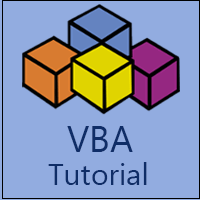Excel VBA Tutorial

VBA stands for Visual Basic for Applications, and event-driven programming language from Microsoft. It is now predominantly used with Microsoft Office applications such as MS Excel, MS-Word, and MS-Access.
This tutorial helps you to learn the basics of Excel VBA. Each of the sections contains related topics with simple examples.
What is VBA
VBA stands for Visual Basic for Applications. And event-driven programming language from Microsoft with Microsoft Office applications such as MSExcel, MS-Word, and MS-Access.
VBA allows you to automate various activities in Excel such as generating reports, preparing charts & graphs, doing calculations, etc. This automation activity is also known as Macro.
VBA helps to build customized applications and solutions to enhance the capabilities of these applications.
The advantage of this facility is that you don’t have any need to install visual basics on your desktop. And installing Office will ultimately help you to achieve the purpose. Also, you can build very powerful tools in MS Excel using linear programming.
VBA can use in all office versions, from MS-Office 97 to MS-Office 2013 and with any available latest versions. Among VBA, Excel VBA is the popular one.
VBA is a high-level language. VBA is a subset of Visual Basic 6.0 BASIC stands for Beginners All-Purpose Symbolic Instruction Code.
Why VBA?
Some points clear to you why use VBA such as:
- VBA uses simple English statements to write the instructions.
- Creating the user interface is a drag, drop, and align the graphical user interface controls in VBA.
- VBA is very simple to learn and required basics programming skill.
- VBA enhance the functionality of excel by allowing you to make excel behave according to your need.
Application of VBA
You think why to use VBA in Excel as MS-Excel itself provides loads of inbuilt functions.
MS-Excel provides only essential inbuilt functions that may not be sufficient to perform complex calculations. Under such circumstances, VBA becomes the most transparent solution.
For example, Using Excel’s built-in formulas is tough to calculate the monthly repayment of the loan. But, it’s easy to program a VBA for this kind of calculations.
VBA Basics
First, you need to know about the basics before starting or write any code. There are some basics given below:
Variable: Variables are the memory locations. And to work with VBA, you will be required to declare variables.
For example: Suppose (2x+ 5y), where x=1 and y=2. In this given expression, x and y are the variables or can be assigned any numbers i.e., 3 and 4, respectively.
Rules for Creating Variables
- Don’t use reserved words: Reserved words are those words which have special meaning in VBA so you can’t use them as variable names.
- The variable name cannot contain space: You cannot define a variable name with space such as the Last Number. You can use LastNumber or Last_Number.
- Use descriptive names: Use descriptive names such as price, quantity, subtotal, etc. this will make your VBA code easy to understand.
Arithmetic Operators: We use the (BODMAS) rule during brackets of division, multiplication, addition, and subtraction when working with an expression which uses multiple different arithmetic operators.
- (+) for addition
- (-) for subtraction
- (*) for multiplication
- (/) for division
Logical Operator: The concept of the logical operator is also applied when working with VBA such as.
- If statements
- AND
- OR
- NOT
- TRUE
- FALSE
Prerequisite
To learn VBA, you should install MS Office, and mainly MS Excel on your computer system.
Audience
Our VBA tutorial is designed for beginners to help them understand the basics of VBA. This tutorial will provide enough knowledge of VBA from where you can take yourself to a higher level of expertise.
Problem
We assure you that you will not find any issue with this VBA tutorial. But if there is any mistake, please post the problem in the contact form.
